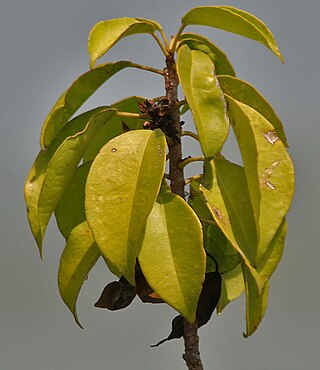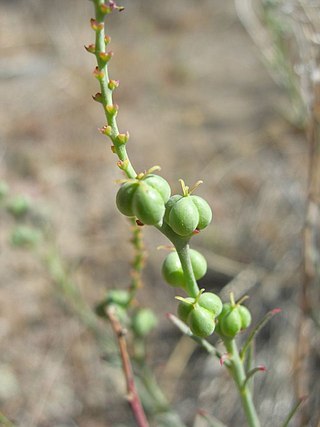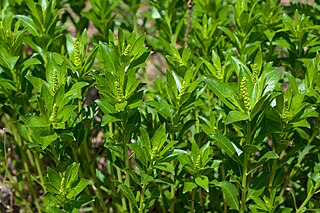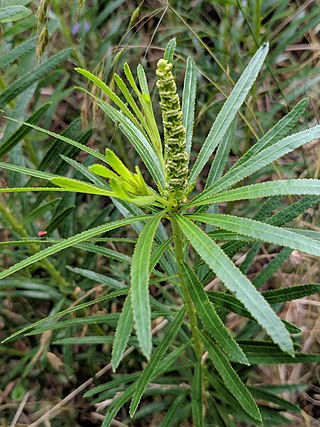| Doa ampla | |
|---|---|
| Scientific classification | |
| Kingdom: | |
| Phylum: | |
| Class: | |
| Order: | |
| Family: | |
| Genus: | |
| Species: | D. ampla |
| Binomial name | |
| Doa ampla (Grote, 1878) | |
| Synonyms | |
| |
Doa ampla is a moth of the family Doidae. It is found from western Texas and Colorado to Arizona, south into Mexico.
The wingspan is about 37 mm.
Larvae have been recorded on feeding on the leaves of Stillingia texana . They probably feed on other Stillingia species as well.
Triadica sebifera is a tree native to eastern China. It is commonly called Chinese tallow, Chinese tallowtree, Florida aspen, chicken tree, gray popcorn tree, or candleberry tree.

Excoecaria is a plant genus of the family Euphorbiaceae, formally described by Linnaeus in 1759. The genus is native to the Old World Tropics.

Stillingia is a plant genus of the family Euphorbiaceae, first described for modern science as a genus in 1767. The genus is native to Latin America, the southern United States, and various islands in the Pacific and Indian Oceans. Toothleaf is a common name for plants in this genus.
Stillingia oil is an oil extracted from the seeds of plants of the Triadica genus such as Triadica sebifera and Triadica cochinchinensis. It is a drying oil used in paints and varnishes, and it is believed to be toxic in China. It must be distinguished from stillingia tallow, a fatty substance that surround the seeds in the fruit and must be removed before extracting the oil.

Stillingia linearifolia is a species of flowering plant in the euphorb family known as queen's-root.

Gadirtha impingens is a moth of the family Nolidae first described by Francis Walker in 1858. It is found from northern India and southern China to Queensland, the Bismarck Archipelago and the Solomon Islands, as well in Japan. The habitat consists of lowland areas up to 2,600 meters, but it is most frequent at elevations ranging from 1,000 to 2,000 meters.

Stillingia lineata is a species of flowering plant in the family Euphorbiaceae, native to Réunion, Mauritius, the South China Sea, Malesia and Fiji.
Stillingia aquatica, known as water toothleaf and corkwood, is a flowering shrub in the genus Stillingia that grows in the Southeastern United States in parts of Georgia, Florida, Alabama, and South Carolina. It is in the spurge family, Euphorbiaceae. Stillingia aquatica was described by Alvan Wentworth Chapman in 1860.
Stillingia argutedentata is a species of flowering plant in the family Euphorbiaceae. It was described by Eugene Jablonszky in 1967. It is native to Minas Gerais, Brazil.
Stillingia bodenbenderi is a species of flowering plant in the family Euphorbiaceae. It was originally described by Otto Kuntze as Sapium bodenbenderi in 1898. It is native to southeastern Brazil and northeastern Argentina.
Stillingia dichotoma is a species of flowering plant in the family Euphorbiaceae. It was described by Johannes Müller Argoviensis in 1863. It is native to Bahia and Rio de Janeiro, Brazil.

Stillingia sylvatica, known as queen's-delight or queen's delight, is a species of flowering plant in the family Euphorbiaceae. It was described in 1767. It is endemic to the south-central and southeastern United States, growing in sandy areas such as sandhills and pine flatwoods.

Stillingia texana, the Texas toothleaf, is a species of flowering plant in the family Euphorbiaceae. It is native to the South Central United States and Mexico. In central Texas it is widespread in upland, calcareous prairies, spreading north to scattered locations in Oklahoma and south to Coahuila. Stillingia texana was described in 1923 by Ivan Murray Johnston.

Stillingia treculiana, Trecul's toothleaf, is a species of flowering plant in the family Euphorbiaceae. It was originally described as Gymnanthes treculianaMüll.Arg. in 1865. It is native to southern Texas in the United States and northeast Mexico, growing in sandy and gravelly soils in dry habitats.
Stillingia saxatilis is a species of flowering plant in the family Euphorbiaceae. It was described in 1874 by Johannes Müller Argoviensis. It is native to Brazil, in Bahia and Minas Gerais.
Stillingia salpingadenia is a species of flowering plant in the family Euphorbiaceae. It is native to northeast Argentina, Bolivia, west-central Brazil, and Paraguay.
Stillingia tenella is a species of flowering plant in the spurge family, Euphorbiaceae. It was originally described as Sapium tenellumPax & K.Hoffm. in 1924. It is native to Bolivia and northwest Argentina.
Stillingia trapezoidea is a species of flowering plant in the family Euphorbiaceae. It was described in 1908. It is native to northeastern Brazil.
Triadica cochinchinensis is a species of tree known as the mountain tallow tree.
Stillingia tallow or Chinese vegetable tallow is a fatty substance extracted from the coat of the seeds of Triadica sebifera or Triadica cochinchinensis. It has traditionally been used for making candles. This product must be distinguished from stillingia oil, that is extracted from the seeds of those trees.